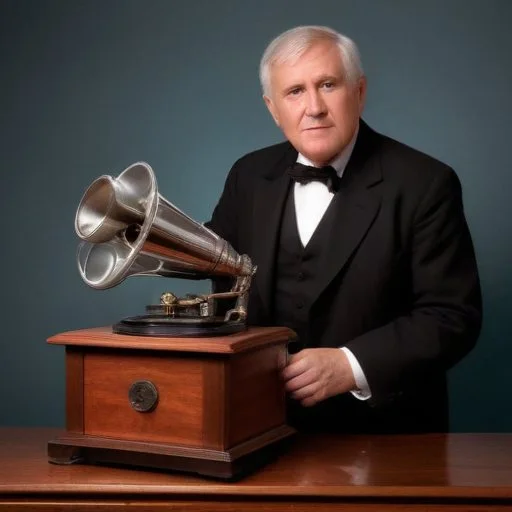In 1877, the world witnessed a groundbreaking innovation that would revolutionize the way we experience sound. On November 29th, Thomas Edison announced his invention of the phonograph, a machine capable of recording and playing back sound, a feat that would change the landscape of music, communication, and entertainment forever.
Thomas Edison's fascination with capturing the human voice began modestly, with cylinders wrapped in tinfoil and a series of experiments that would eventually lead to the creation of the phonograph. His perseverance and determination paid off, as he successfully demonstrated the machine's capabilities, leaving onlookers in awe.
The phonograph was a mechanical device that used a stylus to etch sound waves onto a rotating cylinder coated with tinfoil. This innovative contraption allowed users to record and play back sound with remarkable fidelity, a concept that was both mesmerizing and unsettling to the public.
The phonograph's potential was immense, and its impact on the music industry was immediate. Music recording became a reality, allowing people to experience their favorite artists and songs in the comfort of their own homes. The phonograph also paved the way for the development of new forms of entertainment, such as radio and eventually, television.
The phonograph's invention also had a profound impact on society and culture. It enabled people to connect with music on a deeper level, and it democratized access to music, making it possible for people from all walks of life to enjoy and share music. The phonograph also played a significant role in shaping American culture, as it helped to popularize music genres such as jazz and blues.
"I am experimenting upon an instrument which does for the human voice and other sounds what the terrestrial telegraph does for the dots and dashes of the Morse code." - Thomas Edison
The invention of the phonograph shares similarities with other groundbreaking innovations, such as the invention of the telegraph and the telephone. All three devices revolutionized communication and had a profound impact on society and culture.
Edison's assistant, Charles Batchelor, was present during the phonograph's first demonstration and recalled the moment when Edison spoke the now-famous words "Mary had a little lamb" into the machine. Batchelor reportedly exclaimed, "Gott im Himmel!" (Good God!) upon hearing the recorded voice.
The phonograph's invention paved the way for the development of subsequent sound recording technologies, including gramophones, cassette tapes, and digital recording. It also inspired innovators to explore new forms of communication and entertainment, such as radio and television.
Thomas Edison was awarded the National Medal of Science in 1969 for his contributions to science and technology, including the invention of the phonograph.
The phonograph's invention has had a significant impact on music education, enabling students to study and appreciate music in new and innovative ways. It has also inspired generations of inventors and innovators to pursue careers in science and technology.
The phonograph's impact on culture was multifaceted, with far-reaching consequences for music, art, and society as a whole. The device enabled the widespread dissemination of music, democratizing access to this art form and creating new opportunities for artists and audiences alike.
In the realm of art, the phonograph inspired new forms of creative expression, such as music criticism and journalism. It also influenced the development of new musical genres, including jazz and blues, which emerged in the late 19th and early 20th centuries.
The phonograph's cultural impact was not limited to the arts, however. It also played a significant role in shaping American identity and cultural values. By facilitating the mass production and distribution of music, the phonograph helped to create a shared cultural experience, binding together diverse communities and fostering a sense of national unity.

The phonograph was a technological marvel that paved the way for subsequent innovations in sound recording. The device's mechanical components, including the stylus and cylinder, established the fundamental principles of sound reproduction, which would be refined and improved upon in the decades that followed.
The phonograph's technological legacy can be seen in the development of subsequent sound recording technologies, including the gramophone, cassette tape, and compact disc. Each of these innovations built upon the foundational principles established by Edison's invention, expanding the possibilities for music reproduction and distribution.
Today, the phonograph's technological impact can be seen in the ubiquitous presence of digital music, which has transformed the way we consume and interact with music. From streaming services to portable music players, the phonograph's legacy continues to shape the music industry and our personal relationships with sound.
Thomas Edison was a true visionary, driven by an insatiable curiosity and a passion for innovation. Born in 1847, Edison grew up in a world transformed by industrialization and technological progress, and he was determined to make his own mark on history.
Edison's fascination with sound and communication began at an early age, and he spent much of his career experimenting with devices that could record and transmit the human voice. His perseverance and determination ultimately led to the invention of the phonograph, a triumph that would cement his place in the annals of history.
Despite his many achievements, Edison remained humble and gracious, crediting his assistants and collaborators for their contributions to his work. His legacy extends far beyond the phonograph, inspiring generations of inventors, scientists, and innovators to pursue their passions and push the boundaries of human knowledge.

The phonograph's significance extends beyond its role as a technological innovation, revealing deeper insights into the human experience. The device's ability to capture and reproduce sound highlights the complex relationship between technology and culture, as well as the evolving nature of human communication.
Historical perspectives on the phonograph reveal the ways in which this device reflected and shaped societal values and norms. The phonograph's popularity, for example, reflects the growing demand for entertainment and leisure activities in the late 19th century, as well as the increasing importance of music in American cultural life.
By examining the phonograph within its historical context, we gain a deeper understanding of the dynamic interplay between technology, culture, and society, shedding light on the complex forces that have shaped our modern world.
The phonograph's impact on social dynamics was profound, transforming the way people experienced and interacted with music. The device enabled individuals to access and enjoy music in the comfort of their own homes, creating new possibilities for socialization and community building.
The phonograph also helped to democratize access to music, bridging cultural and socioeconomic divides. By making music more accessible and affordable, the phonograph facilitated the growth of new musical genres and styles, as well as the emergence of new cultural movements and subcultures.
The phonograph's social impact can be seen in the growth of urban entertainment cultures, including the rise of vaudeville, concert halls, and dance clubs. These new forms of entertainment were facilitated by the phonograph's ability to reproduce and disseminate music, creating new opportunities for socialization and community engagement.